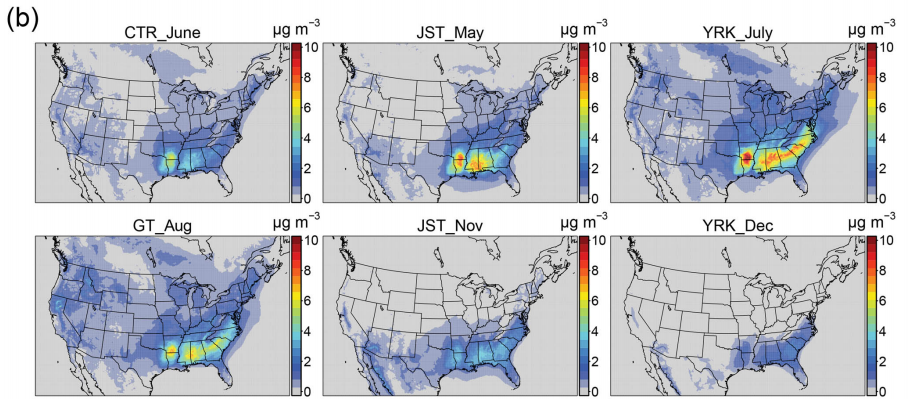Improving the representation of monoterpene chemistry in CMAQ
Organic compounds are an important part of atmospheric reactivity with complex and diverse sources. Measurements of individual species in ambient organic aerosol during the summer of 2013 revealed that oxidation of compounds emitted by vegetation, specifically monoterpenes, were the dominant contributor to summertime organic aerosol in the southeast U.S. (Zhang et al. 2018, Lee et al. 2020). Analysis of datasets around the southeast highlight that monoterpene oxidation products are present in PM2.5 throughout the year (Xu et al. 2018). Nitrogen oxides, mostly from anthropogenic combustion, have a variety of effects on ambient organic aerosol with indications that NOx facilitates biogenic PM (e.g. Pye et al. 2015, Liu et al. 2018, Pye et al. 2019).
The Team at EPA, as part of the CRACMM Collaborative Effort, is building chemical mechanisms for multiple pollutant endpoints and utilizes two complementary approaches to understand how monoterpene oxidation results in ambient PM2.5, hazardous air pollutants (HAPs), and ozone. In one approach, detailed mechanistic models are developed and used to understand atmospherically relevant reactions and products. These detailed approaches often require the development of new chemical reactions as complete representations of monoterpene chemistry are not available. For example, Zhao et al. (2018) constrained autoxidation pathways and RO2+RO2 reactions using laboratory data to reveal that gas-phase dimer production pathways could account for 5-60% of a-pinene SOA. In addition, the work showed that autoxidation, a unique intramolecular reaction that efficiently produces PM, may be 10x faster than previous results. In other work, Pye et al. (2019) developed a detailed representation of OH oxidation to show that autoxidation pathways dictate the abundance of SOA from monoterpenes and influences how anthropogenic emissions regulate biogenic SOA (read more under CMAQ Research Highlights).
The second way the team is approaching development is to build simplified (or condensed) mechanisms that are computationally efficient for use in CMAQ. To prioritize systems for development, detailed mechanisms can be used alongside simplified mechanisms to identify potential avenues of improvement. In work by Skipper et al. (2024), box-model predictions of formaldehyde from CRACMM version 1 chemistry were compared to those from the detailed MCM mechanism. Large discrepancies were observed for the monoterpene system and further investigation indicated that variation of formaldehyde yield between individual compounds within the monoterpene class needed to be better parameterized in CRACMM. As a result, CRACMM version 2 contains updated monoterpene chemistry. The effort to generally improve the representation of monoterpene oxidation in CRACMM led to contemporaneous updates in how monoterpene oxidation products, specifically organic nitrates, influence PM2.5. These complementary approaches of detailed and simplified chemistry modeling will continue to be needed as new information on products and their formation rates are elucidated. See Pye et al. (2024) for a discussion on how community information can be leveraged in this endeavor.
References
Lee, B., D’Ambro, E., Lopez-Hilfiker, F., Schobesberger, S., Mohr, C., Zawadowicz, M., Liu, J., Shilling, J., Hu, W., Palm, B., Jimenez, J., Hao, L., Virtanen, A., Zhang, H., Goldstein, A., Pye, H. O. T., Thornton, J., Resolving ambient organic aerosol formation and aging pathways with simultaneous molecular composition and volatility observations, ACS Earth Space Chem 4(3), 391-402, https://doi.org/10.1021/acsearthspacechem.9b00302, 2020.
Liu, J., Russell, L.M., Ruggeri, G., Takahama, S., Claflin, M.S., Ziemann, P.J., Pye, H.O.T., Murphy, B.N., Xu, L., Ng., N.L., McKinney, K.A., Budisulistiorini, S.H., Bertram, T.H., Nenes, A., Surratt, J.D., Regional similarities and NOx-related increases in biogenic secondary organic aerosol in summertime southeastern U.S., J. Geophys. Res. Atmos., https://doi.org/10.1029/2018JD028491, 2018.
Pye, H. O. T., D’Ambro, E., Lee, B., Schobesberger, S., Takeuchi, M., Zhao, Y., Lopez-Hilfiker, F., Liu, J., Shilling, J., Xing, J., Mathur, R., Middlebrook, A., Liao, J., Welti,A., Graus, M., Warneke, C., de Gouw, J., Holloway, J., Ryerson, T., Pollack, I., Thornton, J. A., Anthropogenic enhancements to production of highly oxygenated molecules from autoxidation. P Natl Acad Sci USA, https://doi.org/10.1073/pnas.1810774116, 2019.
Pye, H. O. T., Luecken, D. J., Xu, L., Boyd, C. M., Ng, N. L., Baker, K., Ayres, B. A., Bash, J. O., Baumann, K., Carter, W. P. L., Edgerton, E., Fry, J. L., Hutzell, W. T., Schwede, D., Shepson, P. B., Modeling the current and future roles of particulate organic nitrates in the southeastern United States, Environ. Sci. Technol., https://doi.org/10.1021/acs.est.5b03738, 2015.
Pye, H. O. T., Schwantes, R.H., Barsanti, K.C, McNeill, V.F., and Wolfe, G.M., Leveraging Scientific Community Knowledge for Air Quality Model Chemistry Parameterizations, EM Magazine, January 2024 article, 2024.
Skipper, T. N., D’Ambro, E. L., Wiser, F. C., McNeill, V. F., Schwantes, R. H., Henderson, B. H., Piletic, I. R., Baublitz, C. B., Bash, J. O., Whitehill, A. R., Valin, L. C., Mouat, A. P., Kaiser, J., Wolfe, G. M., St. Clair, J. M., Hanisco, T. F., Fried, A., Place, B. K., and Pye,* H. O. T.: Role of chemical production and depositional losses on formaldehyde in the Community Regional Atmospheric Chemistry Multiphase Mechanism (CRACMM), EGUsphere [preprint], https://doi.org/10.5194/egusphere-2024-1680, 2024.
Xu, L., Pye, H. O. T., He, J., Chen, Y., Murphy, B. N., and Ng, N. L., Experimental and model estimates of the contributions from biogenic monoterpenes and sesquiterpenes to secondary organic aerosol in the southeastern United States, Atmos. Chem. Phys., 18, 12613-12637, https://doi.org/10.5194/acp-18-12613-2018, 2018.
Zhang, H. et al., Monoterpenes are the largest source of summertime organic aerosol in the southeastern United States, Proc. Natl. Acad. Sci. USA, https://doi.org/10.1073/pnas.1717513115, 2018.
Zhao, Y., Thornton, J.A., Pye, H.O.T.: Quantitative constraints on autoxidation and dimer formation from direct probing of monoterpene-derived peroxy radical chemistry, Proc. Natl. Acad. Sci. USA, https://doi.org/10.1073/pnas.1812147115, 2018.

